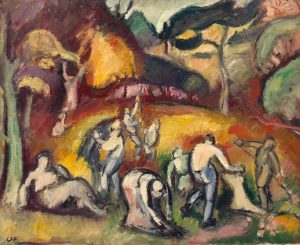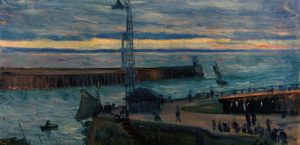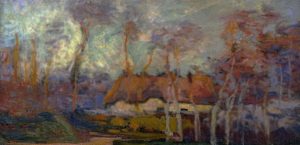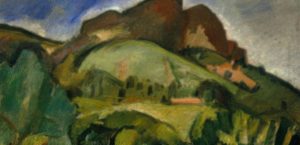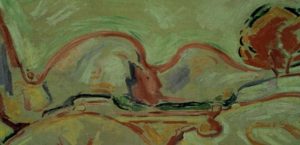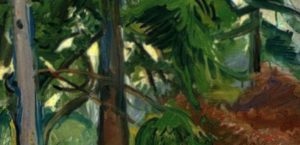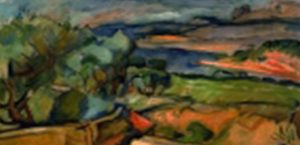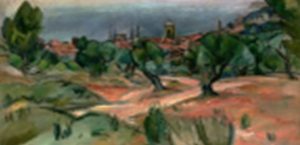Othon Friesz was born on the 6th of February in 1879 in Le Havre, France.
1979 - 1949
Othon Friesz

description
Henri-Achille-Emile-Othon-Friesz was a French painter, graphic designer and decorator, a talented teacher, the founder of the private school of painting in Paris.
His father and grandfather were both seamen and wanted Emille to devote himself to the family business. The boy began to show his artistic ability at an early age, and his parents sent him to the School of Fine Arts in his hometown. There he got acquainted and made friends with Fauvist Raoul Dufy.
Othon Friesz was a member of the Fauvist group, headed by Henri Matisse and is rightly considered one of the brightest representatives of this art movement. In 1906, the artist became one of the founders of The Circle of Contemporary Art – the association of artists, admirers of Le Havre and took an active part in art exhibitions around the world. His contemporaries appreciated the art of Friesz, his paintings were popular with the public and evoked positive reviews of colleagues; in 1933, and the artist was awarded the Order of the Legion of Honor.
Key Ideas:
– Fellow artists called Othon Friesz a romantic among the Fauves for his lyrical stories and closeness to nature. The artist created many landscapes in characteristic bright and pure tones inherent in Fauvism, as well as portraits and still lifes.
– Friesz’ favorite theme was ports and harbors, boats and ships, as well as the noisy life of coastal cities.
– The palette of the artist changes throughout his career from the light impressionistic that was characteristic of him at the beginning of the creative path, to the unrestrained colors of Fauvism and the more restrained shades of the late period.
– Friesz’s paintings are characterized by smooth wavy lines, contrasting color spots, a schematic depiction of people and objects. They are filled with vital energy and bring about positive emotions.
– Like many of his contemporaries, Othon Friesz was in constant search of new ways of expression and original art methods. Experiments with color and form are clearly visible in most of his paintings, where the artist tries to find the most accurate and emotionally expressive way to reflect the world around him.
– In the canvases after 1909, the master tries to escape from any artistic trends. He begins to paint in his own manner, as simple and decorative as possible, although very refined and original.
1879
1899
1903
1905
1907
1912
1914
1920 - 1930
1933
1935 - 1937
1949
The birth of the artist
Entered the School of Fine Arts, where he attended the workshop of Leon Bonn
Thanks to the state scholarship he had received, the artist went to Paris and entered the School of Fine Arts, where he attended the workshop of Leon Bonn.
The debut
The young artist debuted at the Salon of Independent. At about the same time he met Matisse and became a supporter of his artistic method.
Exhibited his works at the Autumn Salon
Exhibited his works at the Autumn Salon together with other Fauvists. Created many colorful landscapes, nude models and still lifes.
Changed his artistic style
Changed his artistic style in the direction of a simplified image and a dynamic composition.
Opened his own art studio
Opened his own art studio, which worked until the outbreak of the First World War. Friesz was a talented teacher. His graduates became outstanding artists.
The artist was drafted into the army
The artist was drafted into the army, where he remained until the end of hostilities in 1919. After his return, Friesz did not resume his painting school but taught occasionally at various educational institutions.
Since 1925, museums in France began to buy his paintings
Over the next 20 years, the painter’s art did not undergo any significant changes. He continued to work in the chosen manner, creating landscapes, interiors and still lifes, and also painted several avant-garde portraits. Since 1925, museums in France began to buy his paintings.
Received a high award
Received a high award – the French Order of the Legion of Honor.
"World"
Turning to applied arts, created and exhibited the carpet “World”. Together with Raoul Dufy became the author of a large panel decorating the pavilion of the World Exhibition in the Palais de Chaillot.
The death
He died on the 10th of January in 1949 in Paris.
Othon Friesz
On Artist
flow
Impressionism
Post-Impressionism
friends
Henri Matisse
Georges Rouault
artists
Camille Pissarro
Paul Cezanne
Vincent van Gogh
Paul Gauguin
Louie Charles
Pablo Picasso
By Artist
flow
Cubism
Expressionism
Abstract art
friends
Raoul Dufy
George Braque
artists
Jacques Bussset
Oscar Gauthier
Gabriel Dosho
F. Kara Kostya

